Integration of Hyperspectral Imaging and Robotics: A Novel Approach to Analysing Cultural Heritage Artefacts
Abstract
1. Introduction
2. Materials and Methods
2.1. Materials
2.2. Methods
2.2.1. Hyperspectral Imaging
2.2.2. Robotic Platform
2.2.3. Object-Specific Imaging Workflow
3. Results
3.1. Painting
3.2. Archaeological Bronzes
3.3. Scientific Contribution
- Adaptive acquisition trajectories and programmable workflows. The six degrees of freedom of the robotic arm enable the system to follow trajectories that adjust to the shape, size, and spatial configuration of objects, overcoming the limitations of linear translation stages or fixed scanning setups. The possibility of storing these trajectories in the system represents an additional advantage, as it allows repeatable and user-independent acquisitions.
- Consistent and reproducible spectral data. Experiments confirm that reliable and reproducible measurements can be obtained even when object orientation or geometry varies. As demonstrated by the geometric transformations calculated for the planar object, minimal distortions occur in the images and stable illumination is maintained throughout repeated acquisitions. This demonstrates that the robotic system can deliver high-quality hyperspectral data comparable to conventional setups while adding flexibility and adaptability.
- Extended access to volumetric objects. The integration of the robotic arm with the hyperspectral camera allows multiple perspectives to be captured, including surfaces that are normally difficult to reach, such as the underside of artefacts. In particular, acquiring the bottom of the objects was made possible thanks to the use of a transparent tray, which does not affect the colour rendition of the object studied and the spectral information retrieved. Such an approach ensures satisfying data quality across all surfaces.
4. Conclusions
Supplementary Materials
Author Contributions
Funding
Data Availability Statement
Acknowledgments
Conflicts of Interest
References
- Picollo, M.; Cucci, C.; Casini, A.; Stefani, L. Hyper-Spectral Imaging Technique in the Cultural Heritage Field: New Possible Scenarios. Sensors 2020, 20, 2843. [Google Scholar] [CrossRef]
- Radpour, R.; Delaney, J.K.; Kakoulli, I. Acquisition of High Spectral Resolution Diffuse Reflectance Image Cubes (350–2500 nm) from Archaeological Wall Paintings and Other Immovable Heritage Using a Field-Deployable Spatial Scanning Reflectance Spectrometry Hyperspectral System. Sensors 2022, 22, 1915. [Google Scholar] [CrossRef]
- Pei, Z.; Huang, Y.M.; Zhou, T. Review on Analysis Methods Enabled by Hyperspectral Imaging for Cultural Relic Conservation. Photonics 2023, 10, 1104. [Google Scholar] [CrossRef]
- Cucci, C.; Delaney, J.K.; Picollo, M. Reflectance hyperspectral imaging for investigation of works of art: Old master paintings and illuminated manuscripts. Acc. Chem. Res. 2016, 49, 2070–2079. [Google Scholar] [CrossRef] [PubMed]
- Liu, L.; Delnevo, G.; Mirri, S. Unsupervised hyperspectral image segmentation of films: A hierarchical clustering-based approach. J. Big Data 2023, 10, 31. [Google Scholar] [CrossRef]
- Grillini, F.; de Ferri, L.; Pantos, G.A.; George, S.; Veseth, M. Reflectance imaging spectroscopy for the study of archaeological pre-Columbian textiles. Microchem. J. 2024, 200, 110168. [Google Scholar] [CrossRef]
- Cutajar, J.D.; Babini, A.; Deborah, H.; Hardeberg, J.Y.; Joseph, E.; Frøysaker, T. Hyperspectral imaging analyses of cleaning tests on Edvard Munch’s monumental Aula paintings. Stud. Conserv. 2022, 67 (Suppl. S1), 59–68. [Google Scholar] [CrossRef]
- Cucci, C.; Picollo, M.; Chiarantini, L.; Uda, G.; Fiori, L.; De Nigris, B.; Osanna, M. Remote sensing hyperspectral imaging for applications in archaeological areas: Non-invasive investigations on wall paintings and on mural inscriptions in the Pompeii site. Microchem. J. 2020, 158, 105082. [Google Scholar] [CrossRef]
- Baillet, V.; Chapoulie, R.; Dutailly, B.; Galluzzi, F.; Mora, P.; Mounier, A. A new approach to locate, characterise and restore in 3D polychromy of Apollo’s temple at Delphi (4th century B. C.). Digit. Appl. Archaeol. Cult. Herit. 2024, 34, e00345. [Google Scholar] [CrossRef]
- Galluzzi, F.; Manca, R.; Puntin, M.; Raneri, S.; Sciuto, C.; Benvenuti, M.; Chapoulie, R. Maiolica seen by Vis–NIR hyperspectral imaging spectroscopy: The application of an ultraportable camera at the Museo Nazionale del Bargello. Eur. Phys. J. Plus 2024, 139, 629. [Google Scholar] [CrossRef]
- Liggins, F.; Vichi, A.; Liu, W.; Hogg, A.; Kogou, S.; Chen, J.; Liang, H. Hyperspectral imaging solutions for the non-invasive detection and automated mapping of copper trihydroxychlorides in ancient bronze. Herit. Sci. 2022, 10, 142. [Google Scholar] [CrossRef]
- Radpour, R.; Kleynhans, T.; Facini, M.; Pozzi, F.; Westerby, M.; Delaney, J.K. Advances in Automated Pigment Mapping for 15th-Century Manuscript Illuminations Using 1-D Convolutional Neural Networks and Hyperspectral Reflectance Image Cubes. Appl. Sci. 2024, 14, 6857. [Google Scholar] [CrossRef]
- Vlachou-Mogire, C.; Danskin, J.; Gilchrist, J.R.; Hallett, K. Mapping Materials and Dyes on Historic Tapestries Using Hyperspectral Imaging. Heritage 2023, 6, 3159–3182. [Google Scholar] [CrossRef]
- Gabrieli, F.; Delaney, J.K.; Erdmann, R.G.; Gonzalez, V.; van Loon, A.; Smulders, P.; Berkeveld, R.; van Langh, R.; Keune, K. Reflectance Imaging Spectroscopy (RIS) for Operation Night Watch: Challenges and Achievements of Imaging Rembrandt’s Masterpiece in the Glass Chamber at the Rijksmuseum. Sensors 2021, 21, 6855. [Google Scholar] [CrossRef] [PubMed]
- Wang, S.; Cen, Y.; Qu, L.; Li, G.; Chen, Y.; Zhang, L. Virtual Restoration of Ancient Mold-Damaged Painting Based on 3D Convolutional Neural Network for Hyperspectral Image. Remote Sens. 2024, 16, 2882. [Google Scholar] [CrossRef]
- Tang, X.; Yan, J.; Zhang, P.; Dong, W.; He, Z.; Qiu, S.; Zeng, Z. Digital restoration of mural paintings from late Tang tomb M1373 in Xi’an based on hyperspectral analysis and image interaction processing. Herit. Sci. 2025, 13, 192. [Google Scholar] [CrossRef]
- Daniel, F.; Mounier, A. Mobile hyperspectral imaging for the non-invasive study of a mural painting in the Belves Castle (France, 15th C). STAR Sci. Technol. Archaeol. Res. 2015, 1, 81–88. [Google Scholar] [CrossRef][Green Version]
- Mindermann, S.; Thalguter, N.; Angelin, E.M.; Sessa, C.; Cucci, C.; Stege, H.; Danzl, T. Mobile, ground-based VNIR-SWIR hyperspectral imaging for cultural heritage applications. Towards the study of complex architectural surfaces. In Proceedings of the International Association of Spectral Imaging (IASIM), Bilbao, Spain, 6–10 July 2024. [Google Scholar][Green Version]
- Picollo, M.; Casini, A.; Cucci, C.; Jussila, J.; Poggesi, M.; Stefani, L. A New Compact VNIR Hyperspectral Imaging System for Non-Invasive Analysis in the Fine Art and Architecture Fields. In Proceedings of the Electronic Imaging & the Visual Arts, EVA 2018, Florence, Italy, 9–10 May 2018; Firenze University Press: Florence, Italy, 2018; pp. 69–74. [Google Scholar][Green Version]
- Monico, L.; Cartechini, L.; Rosi, F.; Chieli, A.; Grazia, C.; De Meyer, S.; Nuyts, G.; Vanmeert, F.; Janssens, K.; Cotte, M.; et al. Probing the chemistry of CdS paints in The Scream by in situ noninvasive spectroscopies and synchrotron radiation x-ray techniques. Sci. Adv. 2020, 6, eaay3514. [Google Scholar] [CrossRef]
- Pietroni, E.; Botteon, A.; Buti, D.; Chirivì, A.; Colombo, C.; Conti, C.; Di Carlo, A.L.; Magrini, D.; Mercuri, F.; Orazi, N.; et al. “Codex 4D” Project: Interdisciplinary Investigations on Materials and Colors of De Balneis Puteolanis (Angelica Library, Rome, Ms. 1474). Heritage 2024, 7, 2755–2791. [Google Scholar] [CrossRef]
- Guglielmi, V.; Comite, V.; Pini, C.A.; Bergomi, A.; Colella, M.; Lombardi, C.A.; Provera, M.; Preda, F.; Fermo, P. Hyperspectral Imaging and Raman Analyses of the Red Decoration of the St. Mauro Altar in St. Salvatore’s Church (Pavia). In Proceedings of the IMEKO TC4 International Conference on Metrology for Archaeology and Cultural Heritage, Conseca, Italy, 19–21 October 2022. [Google Scholar]
- Ardini, B.; Corti, M.; Ghirardello, M.; Di Benedetto, A.; Berti, L.; Cattò, C.; Goidanich, S.; Sciutto, G.; Prati, S.; Valentini, G.; et al. Enhancing hyperspectral imaging through macro and multi-modal capabilities. J. Phys. Photonics 2024, 6, 035013. [Google Scholar] [CrossRef]
- Atefi, A.; Ge, Y.; Pitla, S.; Schnable, J. Robotic Technologies for High-Throughput Plant Phenotyping: Contemporary Reviews and Future Perspectives. Front. Plant Sci. 2021, 12, 611940. [Google Scholar] [CrossRef]
- Chen, Z.; Wang, J.; Jin, J. Fully automated proximal hyperspectral imaging system for high-resolution and high-quality in vivo soybean phenotyping. Precision Agric. 2023, 24, 2395–2415. [Google Scholar] [CrossRef]
- Hanson, N.; Lvov, G.; Padir, T. Occluded object detection and exposure in cluttered environments with automated hyperspectral anomaly detection. Front. Robot. AI 2023, 9, 982131. [Google Scholar] [CrossRef]
- Schindelin, J.; Arganda-Carreras, I.; Frise, E.; Kaynig, V.; Longair, M.; Pietzsch, T.; Preibisch, S.; Rueden, C.; Saalfeld, S.; Schmid, B.; et al. Fiji: An open-source platform for biological-image analysis. Nat. Methods 2012, 9, 676–682. [Google Scholar] [CrossRef] [PubMed]
- Lowe, D.G. Distinctive Image Features from Scale-Invariant Keypoints. Int. J. Comput. Vis. 2004, 60, 91–110. [Google Scholar] [CrossRef]
- Hartley, R.; Zisserman, A. Projective Geometries and Transformation of 2D. In Multiple View Geometry in Computer Vision, 2nd ed.; Cambridge University Press: Cambridge, UK, 2004; pp. 25–64. [Google Scholar]
- Szeliski, R. Image Formation. In Computer Vision: Algorithms and Applications; Springer International Publishing: Cham, Switzerland, 2022; pp. 27–83. [Google Scholar]
- Neher, R.A.; Mitkovski, M.; Kirchhoff, F.; Neher, E.; Theis, F.J.; Zeug, A. Blind source separation techniques for the decomposition of multiply labeled fluorescence images. Biophys. J. 2009, 96, 3791–3800. [Google Scholar] [CrossRef] [PubMed]
- Liu, W.; Li, M.; Wu, N.; Liu, S.; Chen, J. A new application of Fiber optics reflection spectroscopy (FORS): Identification of “bronze disease” induced corrosion products on ancient bronzes. J. Cult. Herit. 2022, 49, 19–27. [Google Scholar] [CrossRef]
- Orsilli, J.; Caglio, S. Combined Scanned Macro X-Ray Fluorescence and Reflectance Spectroscopy Mapping on Corroded Ancient Bronzes. Minerals 2024, 14, 192. [Google Scholar] [CrossRef]
- Goyal, D.K.; Yadav, R.; Kant, R. An integrated hybrid methodology for estimation of absorptivity and interface temperature in laser transmission welding. Int. J. Adv. Manuf. Technol. 2022, 121, 3771–3786. [Google Scholar] [CrossRef]
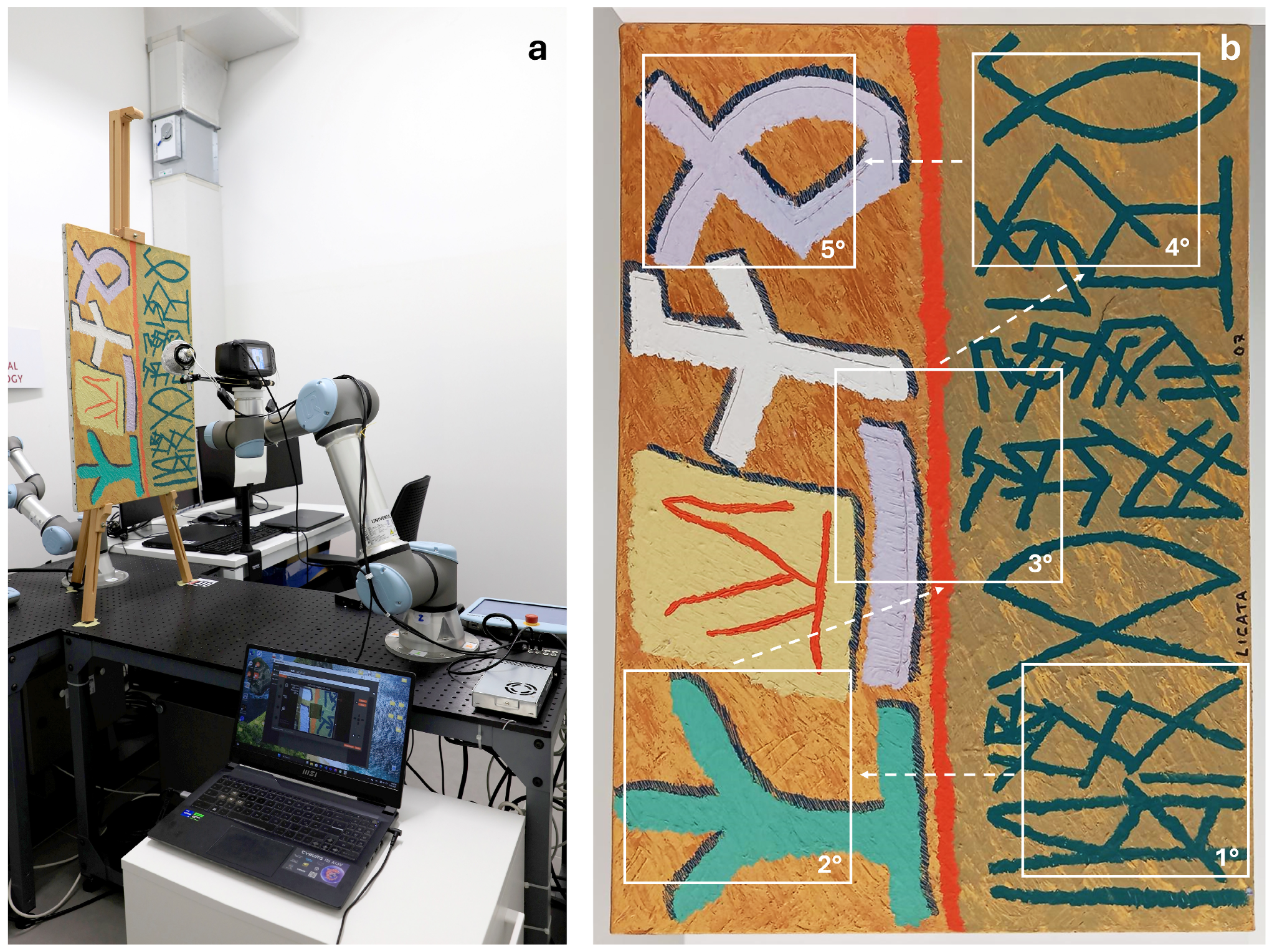
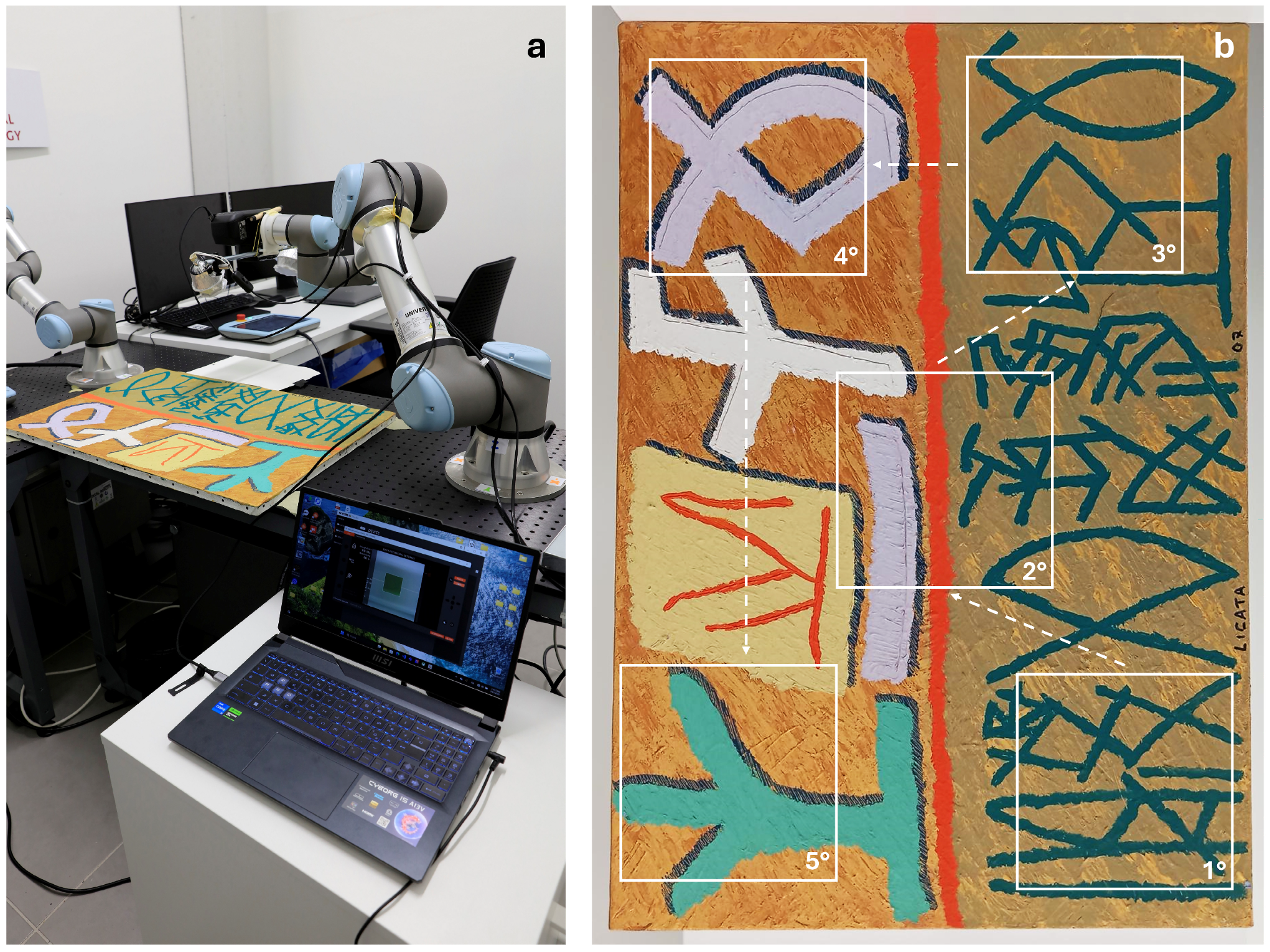

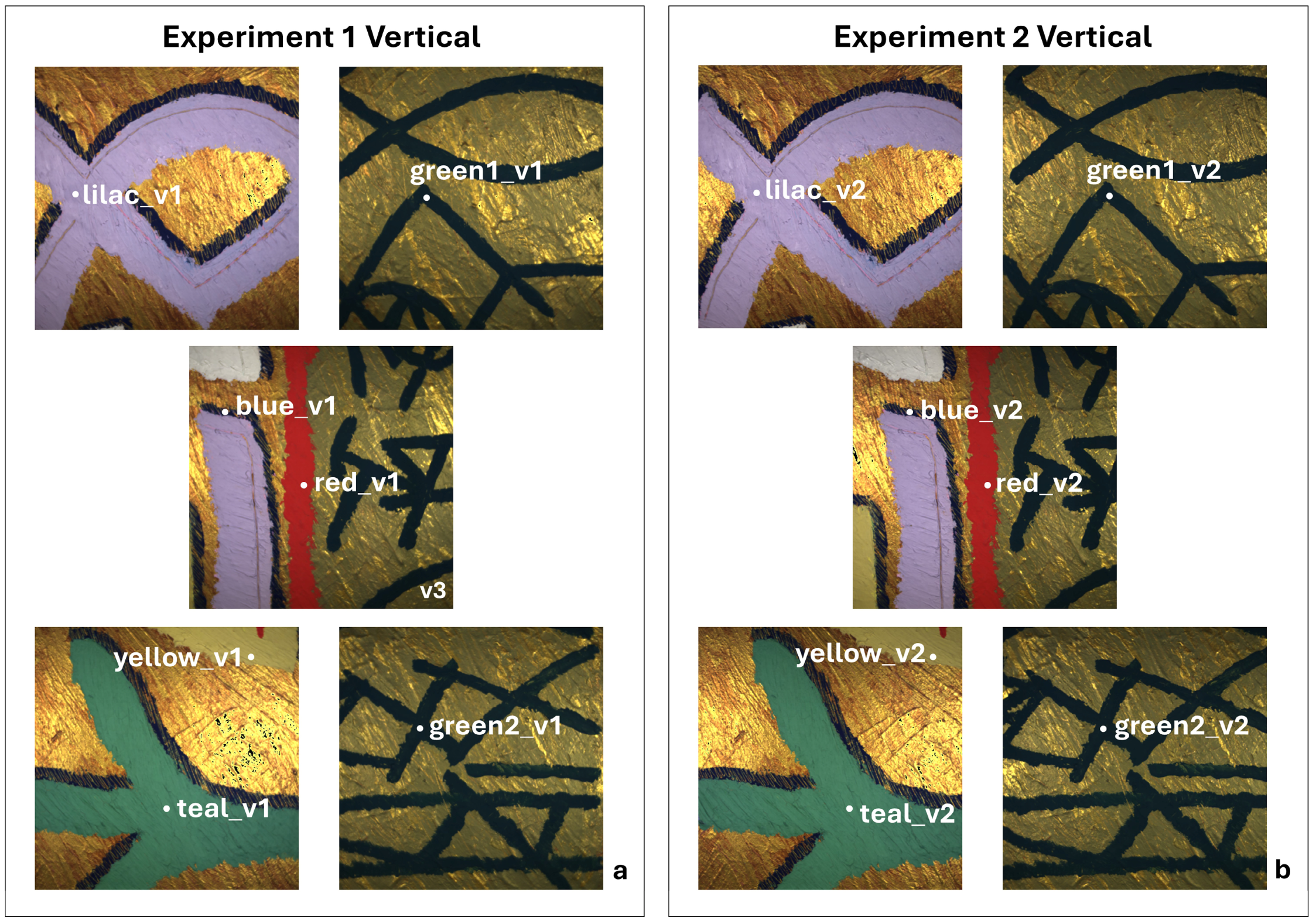

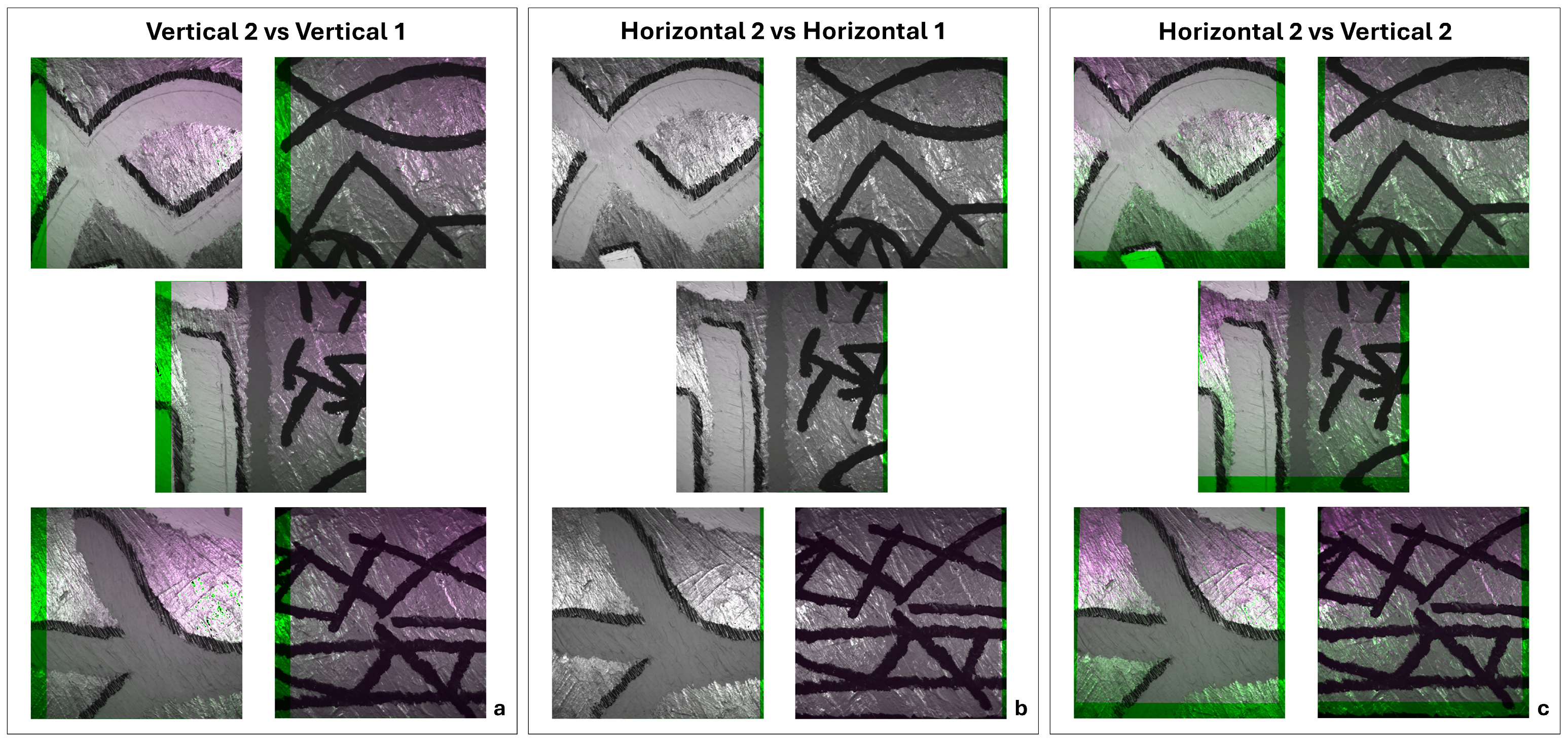
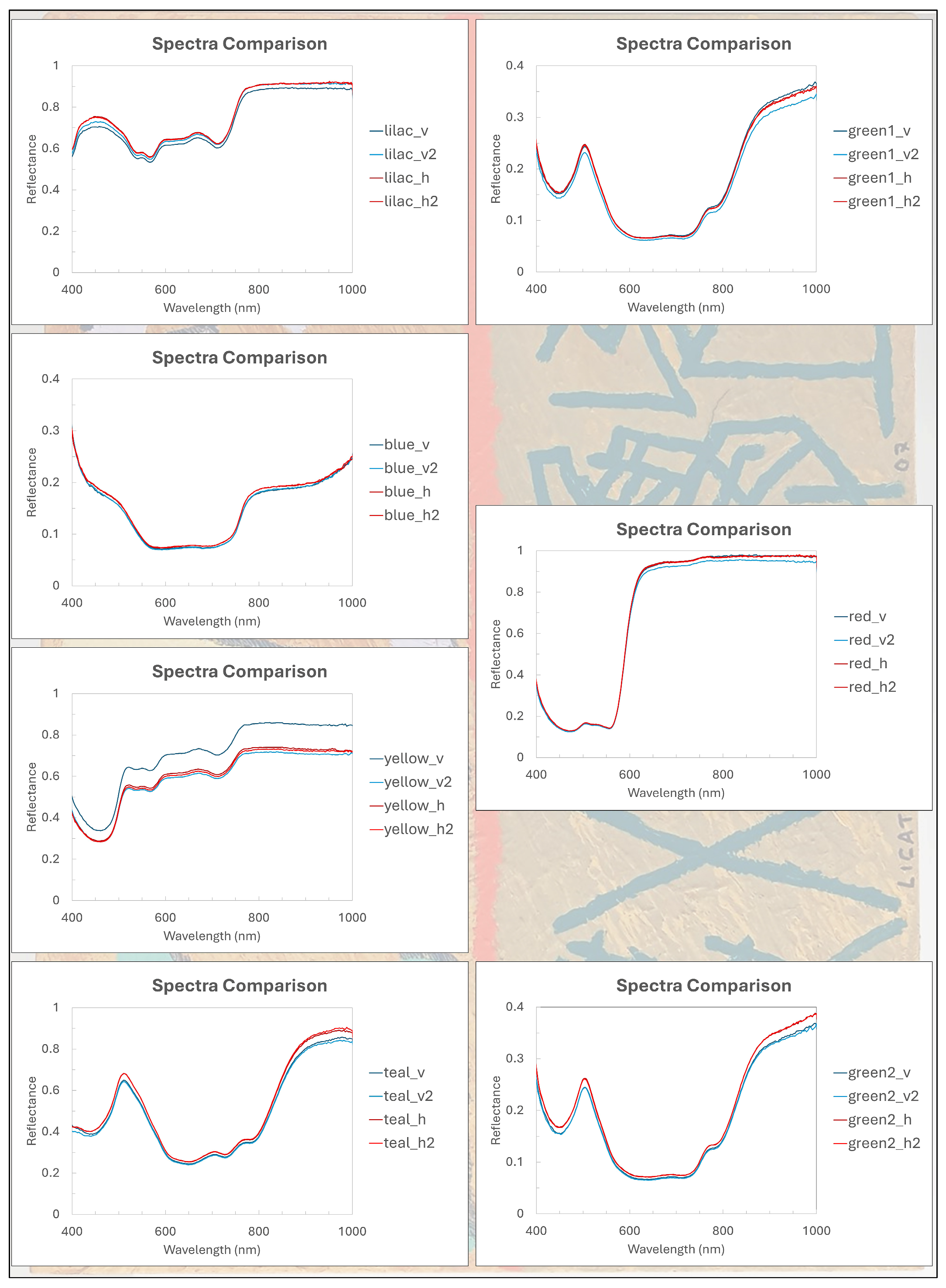

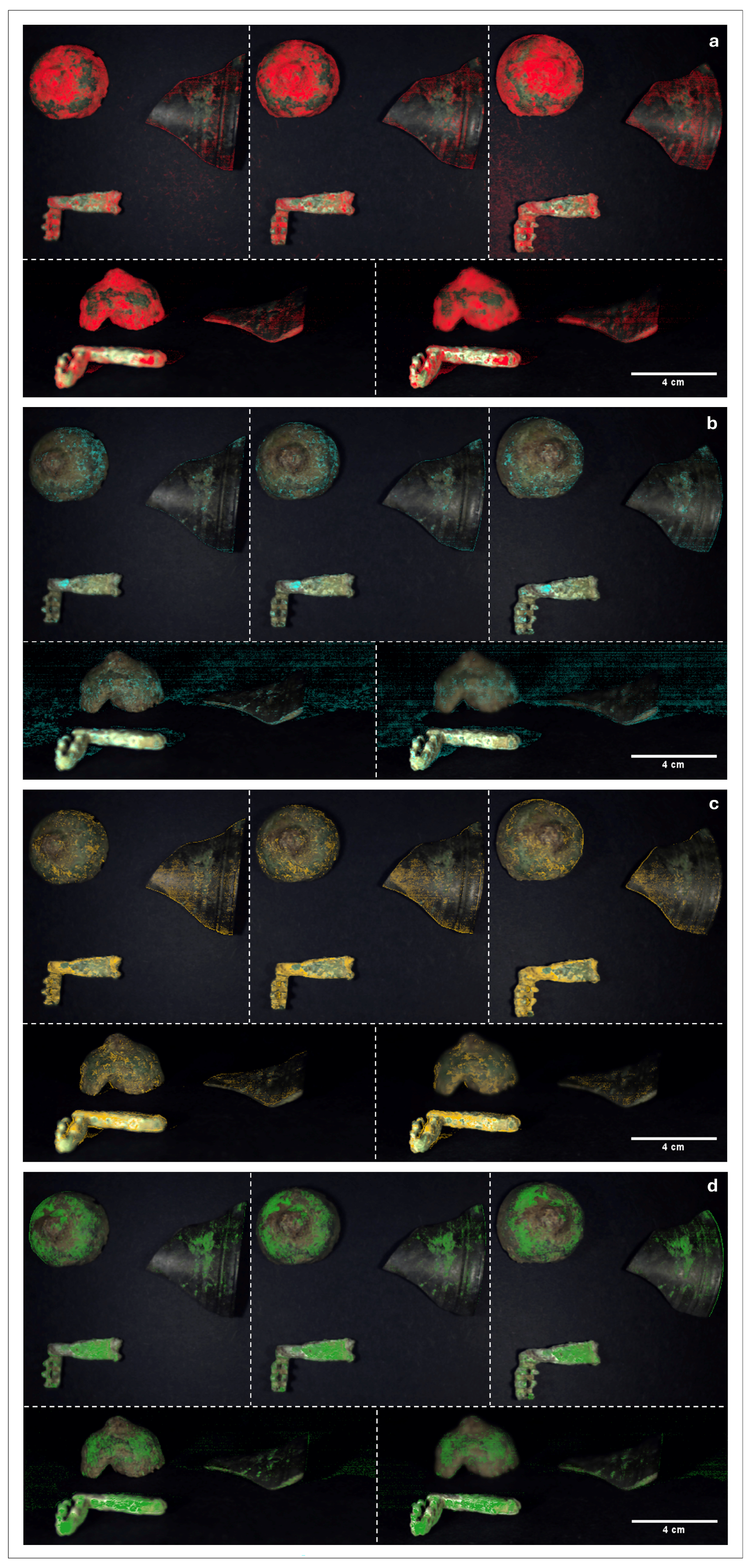

Disclaimer/Publisher’s Note: The statements, opinions and data contained in all publications are solely those of the individual author(s) and contributor(s) and not of MDPI and/or the editor(s). MDPI and/or the editor(s) disclaim responsibility for any injury to people or property resulting from any ideas, methods, instructions or products referred to in the content. |
© 2025 by the authors. Licensee MDPI, Basel, Switzerland. This article is an open access article distributed under the terms and conditions of the Creative Commons Attribution (CC BY) license (https://creativecommons.org/licenses/by/4.0/).
Share and Cite
Babini, A.; Frascella, S.; Sech, G.; Andriulo, F.; Cannella, F.; Marchello, G.; Traviglia, A. Integration of Hyperspectral Imaging and Robotics: A Novel Approach to Analysing Cultural Heritage Artefacts. Heritage 2025, 8, 417. https://doi.org/10.3390/heritage8100417
Babini A, Frascella S, Sech G, Andriulo F, Cannella F, Marchello G, Traviglia A. Integration of Hyperspectral Imaging and Robotics: A Novel Approach to Analysing Cultural Heritage Artefacts. Heritage. 2025; 8(10):417. https://doi.org/10.3390/heritage8100417
Chicago/Turabian StyleBabini, Agnese, Selene Frascella, Gregory Sech, Fabrizio Andriulo, Ferdinando Cannella, Gabriele Marchello, and Arianna Traviglia. 2025. "Integration of Hyperspectral Imaging and Robotics: A Novel Approach to Analysing Cultural Heritage Artefacts" Heritage 8, no. 10: 417. https://doi.org/10.3390/heritage8100417
APA StyleBabini, A., Frascella, S., Sech, G., Andriulo, F., Cannella, F., Marchello, G., & Traviglia, A. (2025). Integration of Hyperspectral Imaging and Robotics: A Novel Approach to Analysing Cultural Heritage Artefacts. Heritage, 8(10), 417. https://doi.org/10.3390/heritage8100417





